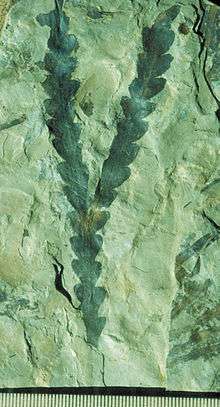Dicroidium
| Dicroidium Temporal range: Triassic | |
|---|---|
 | |
| Dicroidium odontopteroides fossil leaf, Late Triassic Molteno Formation near Birds River South Africa. | |
| Scientific classification | |
| Kingdom: | Plantae |
| Division: | Pteridospermatophyta |
| Order: | Peltaspermales |
| Family: | Corystospermaceae |
| Genus: | Dicroidium Gothan (1912) |
| Species | |
| |
Dicroidium is an extinct genus of fork-leaved seed ferns that were distributed over Gondwana during the Triassic (252 to 201 million years ago). Their fossils are known from South Africa, Australia, New Zealand, South America and Antarctica. They were first discovered in Triassic sediments of Tasmania by Morris in 1845.[4]
Description
The leaves are similar to those of modern ferns but like all seed ferns (Pteridospermophyta) were thick and had substantial cuticles. Dicroidium differs from other seed fern leaves in having a forked rachis; giving the appearance of two fern leaves joined at the base. These plants had male and female reproductive structures. Following the form generic nomenclature of paleobotany, male pollen-bearing structures are separately named Pteruchus and the female structures Umkomasia.[5]
Whole plant reconstructions
Different organs attributed to the same original plant can be reconstructed from co-occurrence at the same locality and from similarities in the stomatal apparatus and other anatomical peculiarities of fossilized cuticles.
- Dicroidium odontopteroides may have been produced by the same plant as Umkomasia macleanii (ovulate structures) and Pteruchus africanus (pollen organs).[6]
- Dicroidium zuberi may have been produced by the same plant as Umkomasia feistmantelii (ovulate structures) and Pteruchus barrealensis (pollen organs)[7]
References
- ↑ THE TRIASSIC TAPHOFLORA FROM PARANA BASIN, SOUTHERN BRAZIL
- ↑ Retallack G.J. (1985). "Triassic fossil plant fragments from marine rocks of the Murihiku Supergroup, New Zealand". Journal of the Royal Society of New Zealand. 15: 1–26. doi:10.1080/03036758.1985.10421741.
- ↑ Passo das Tropas, Santa Maria, RS Marco bioestratigráfico triássico na evolução paleoflorística do Gondwana na Bacia do Paraná.
- ↑ Strzelecki, P.E. (1845). Physical descriptions of New South Wales and van Diemens Land. Brown, Green and Longmans, London. pp. 422 pp.
- ↑ http://www.fossilmuseum.net/plantfossils/Umkomasia/Umkomasia.htm
- ↑ Retallack, G.J.; Dilcher, D.L. (1988). "Reconstructions of selected seed ferns". Missouri Botanical Garden Annals. 75: 1010–1057. doi:10.2307/2399379.
- ↑ Retallack G.J. (1977). "Reconstructing Triassic vegetation of southeastern Australia: a new approach to the biostratigraphy of Gondwanaland". Alcheringa. 1: 247–265. doi:10.1080/03115517708527763.
- Bomfleur, B. and Kerp, H. (2010). Dicroidium diversity in the Upper Triassic of north Victoria Land, East Antarctica.
